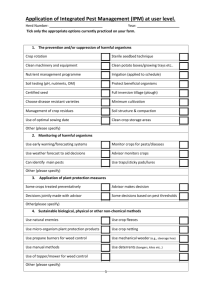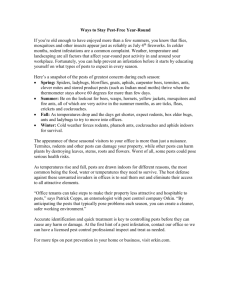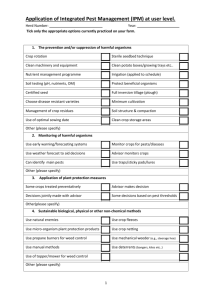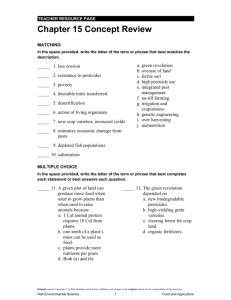Pest Management
advertisement
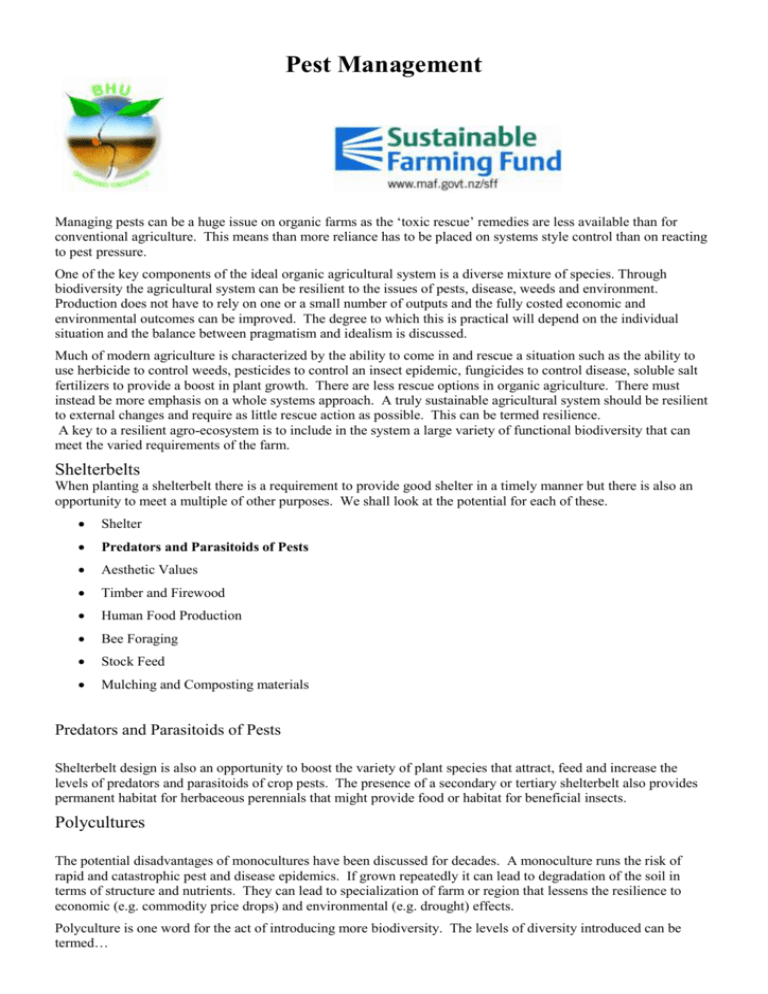
Pest Management Managing pests can be a huge issue on organic farms as the ‘toxic rescue’ remedies are less available than for conventional agriculture. This means than more reliance has to be placed on systems style control than on reacting to pest pressure. One of the key components of the ideal organic agricultural system is a diverse mixture of species. Through biodiversity the agricultural system can be resilient to the issues of pests, disease, weeds and environment. Production does not have to rely on one or a small number of outputs and the fully costed economic and environmental outcomes can be improved. The degree to which this is practical will depend on the individual situation and the balance between pragmatism and idealism is discussed. Much of modern agriculture is characterized by the ability to come in and rescue a situation such as the ability to use herbicide to control weeds, pesticides to control an insect epidemic, fungicides to control disease, soluble salt fertilizers to provide a boost in plant growth. There are less rescue options in organic agriculture. There must instead be more emphasis on a whole systems approach. A truly sustainable agricultural system should be resilient to external changes and require as little rescue action as possible. This can be termed resilience. A key to a resilient agro-ecosystem is to include in the system a large variety of functional biodiversity that can meet the varied requirements of the farm. Shelterbelts When planting a shelterbelt there is a requirement to provide good shelter in a timely manner but there is also an opportunity to meet a multiple of other purposes. We shall look at the potential for each of these. Shelter Predators and Parasitoids of Pests Aesthetic Values Timber and Firewood Human Food Production Bee Foraging Stock Feed Mulching and Composting materials Predators and Parasitoids of Pests Shelterbelt design is also an opportunity to boost the variety of plant species that attract, feed and increase the levels of predators and parasitoids of crop pests. The presence of a secondary or tertiary shelterbelt also provides permanent habitat for herbaceous perennials that might provide food or habitat for beneficial insects. Polycultures The potential disadvantages of monocultures have been discussed for decades. A monoculture runs the risk of rapid and catastrophic pest and disease epidemics. If grown repeatedly it can lead to degradation of the soil in terms of structure and nutrients. They can lead to specialization of farm or region that lessens the resilience to economic (e.g. commodity price drops) and environmental (e.g. drought) effects. Polyculture is one word for the act of introducing more biodiversity. The levels of diversity introduced can be termed… Alpha diversity: a variety of species within one field. Beta diversity: a mixed farm with paddocks of different crop species Gamma diversity: variation in farm types within a region In some parts of the world, even gamma diversity can be absent e.g. the corn belt in the USA. This has the economic advantage of ensuring a high level and low cost of relevant infrastructure. The downside is poor resilience of the economy, greater reliance on imported materials such as fertilizer and crop protection chemicals and a greater distance for transporting produce. There is also a high risk of of pest and disease spread. In organic agriculture there is typically an encouragement into the alpha level of diversity. The benefits of this increased biodiversity include a more resilient system and if designed right, a more productive system. The potential downside is that mechanization becomes increasingly more difficult and complexity of harvest and marketing is greater. Intercropping Intercropping is the act of planting two or more crops in combination. This is practiced extensively in some parts of China and Latin America and has been adopted in many other countries. Further experimentation is being conducted in Western countries to see how compatible the intercropping system is with a western mechanized style of farming. Where practiced right, intercropping can result in a higher overall dollar yield per hectare than simply growing one crop. Advantages can include… Reduced root competition between species with different root systems Overall better capture of sunlight resource for photosynthesis Better weed control through better ground cover and varied root competition Less potential for epidemics and damage from pests and diseases There are numerous other potential advantages depending on the choice of polyculture or intercropping species. Specific examples include the use of corn to provide shelter or crop support, the use of legumes to aid the nitrogen balance of the crop and the use of deep rooting chicory to capture nutrients otherwise lost to leaching. The value of multiple pasture species in livestock systems is covered in Module 9 on Livestock Husbandry. Diversity – Pest and Disease Effects One of the benefits of intercropping mentioned above was a reduction in epidemics and damage from pests and diseases. The potential causes of this have been described as… Disruptive Crop Hypothesis – that a varied collection of crop plants make spread and multiplication of pest and disease epidemics more difficult and overall less of an issue. The Disruptive Crop Hypothesis includes aspects included by some researchers in the alternatively named “Resource Concentration Hypothesis”. Visual and chemical stimuli serve to assist pests in locating sutiable host plants. A monoculture of hosts provides a perfect opportunity for ease of a pest finding the host. Interference from non-host plants include a simple reduction in density of host plants, confusion in chemical stimuli or physical obstruction of pest progress. Pests are also found to be more likely to leave an area once landing on a non-host plant whereas they are inclined to stay longer within a close proximity if they have successfully found a host. Trap Crop Hypothesis – that pests finding alternative hosts where there effects have little consequence for production Trap crop species can include plants of suitable species playing host to plant parasitic nematodes. The trap crops are then ploughed in before the nematodes breed. Trap crops or alternative feeding species may be a dangerous strategy with for example the planting of bird feeding species to reduce grain herbivory often resulting in quite the opposite effect because of the attraction to and build up of bird numbers on the farm. But there has been field success with, for example, the use of black mustard (Brassica nigra) as a trap crop planted around a field of sweetcorn in reducing green vegetable bug (Nezara viridula) – the mustard is cultivated into the ground with the pest before a new generation of pest has been produced.. Enemies Hypothesis – that more predators and parasites of pests are provided due to e.g. flower or habitat provision It is predicted that a polyculture will attract greater numbers of predators and parasitoids of plant pests than will a monoculture. This can be due to the provision of better conditions for shelter and habitation as well as provision of suitable food sources. Good distribution of suitable flowers (over time and around the area) is important and can be managed for. Attention can also be paid to ground cover vegetation to assist habitation of ground based predators. A diversity of species with similar plant pests providing more continuous food for maintained predators and parasitoid levels can be another means of the enemies hypothesis working. Conservation Biological Control Conservation Biological Control (CBC) involves augmenting the level or effect of natural predators and parasitoids of pests. In some cases CBC can be achieved simply by reducing or eliminating spray programmes. Much research internationally and at Lincoln University in particular has focussed on the use of plants that provide a pollen and/or nectar source for the beneficial insects. Beneficial Flowering Plants Much of the research and subsequent practical application has involved the creation of strips or vineyard understoreys with flowering plants. Floral strips can fit into horticultural practice since they need not take much space and they can be planted tens of metres apart. Beetle Banks Planting strips of vegetation can serve as providing “beetle banks”, which are habitat for predatory ground beetles and spiders. These can provide effective control of plant pests including caterpillars and aphids. In Europe, beetle banks have been planted of cocksfoot (Dactylis glomerata) or Yorkshire fog (Holcus lanatus) Perennial Components Part of good system design includes the incorporation of CBC plants into shelterbelts, orchard understories, field margins and within permanent borders. Examples of shelterbelt species include Viburnum spp. and Choysia spp. Some of the perennial species will also provide habitat for beneficial insects though in design terms this may have to be tempered with considerations of encouraging some insect pests (e.g. carrot rust fly) and bird pests. An option for orchard understories is to include CBC plant species for e.g. control of caterpillar pests (e.g. umbelliferous flowering plants like cow parsley Anthriscus sylvestris, fennel Foeniculum vulgare, and wild carrot Daucus carota). Timing of Flowering In the design of good CBC, attention should be paid to the timing of flowering. Ideally, flowering should be occurring before during and after the main period of pest susceptibility to the beneficial insects attracted/fed by the CBC plants. Many CBC plants are quick maturing and so can be planted as required, often with successional sowings ensuring a continued presence of flowers over the period required (e.g. Phacelia tanacetifolia, broad bean Vicia faba, buckwheat Fagopyrum esculentum, coriander Coriandrum sativum, pak choi Brassica campestris, mustard Brassica rapa). Other CBC flowering plants have an extended flowering season of several weeks (e.g. Viburnum spp. and fennel) and even year round in some places (cow parsley). Examples of the use of beneficial flowering plants and habitat plants are listed below (Table 7.1) according to the animals (agents) they attract/house/feed and the pests they control (targets). Conservation Biological Control Planting Strategies Agent Targets Feeding Plants Hover flies Larvae eat aphids Feverfew, Phacelia, parsley, mustard, Anthemis tinctoria Lacewings Larvae eat aphids, spider mites Angelica, Buckwheat, canola Coreopsis, mustard, pak choi, sunflower Ladybird Adults and larvae eat aphids, spider mites Angelica, buckwheat, buddleia, coreopsis, coriander, dill, fennel lambs quarters, yarrow Sheltering Plants Agent Targets Feeding Plants Sheltering Plants Aphid parasitic wasps Aphids parasitised (eggs laid in aphids) different species of wasps for different aphid species Canola, Coreopsis, cow parsley, dill, fennel, Queen Anne’s lace, mustard, pak choi, vetch, zinnias Ichneumon Wasps Parasitism, laying eggs in diamond back moth caterpillars on brassicas Canola, cow parsley, mustard, pak choi, Queen Anne’s lace Chalcid Parasitism, laying eggs in codling moth caterpillars and many other moths and butterfly larvae. Canola, cow parsley, mustard, pak choi, Queen Anne’s lace Braconid Wasps Parasitism, laying eggs in cabbage white butterfly, leaf roller caterpillar Broad bean, buckwheat, canola, cow parsley, mustard, pak choi, Queen Anne’s lace Tachinid flies Parasitism, laying eggs in cutworms, leaf roller caterpillar, grass grub Anthemis tinctoria Predatory ground beetles, rove beetles Argentine stem weevil, carrot rust fly, grass grub, maggots, mites, slugs, snails Undersowing plants, covercrops, cereals, grasses, crop residues, shelterbelt litter Centipedes General pests including caterpillars, slugs, worms Undersowing plants, covercrops, grasses, crop residues, shelterbelt litter Other Aspects of Conservation Biological Control As well as purposefully planting or introducing beneficial plants and reducing or eliminating spray programmes, there are other management decisions that can be taken to enhance CBC. Some of these include… Maintaining pasture strips to provide beneficial insect and spider habitat Strip harvesting e.g. harvesting strips of lucerne at a time to allow habitation for beneficial insects to control potential pests causing problems on harvested areas Alternating rows of an orchard area for mowing/control of understorey allowing the other rows to provide feed and habitation for beneficial insects until the mown area has regrown Including mixed herbley pasture in the crop rotation In some cases allowing crop residues to remain and provide habitat for e.g. predatory ground beetles Substitutive vs. System Design The whole system approach can be compared and contrasted with a “substitutive” approach. If the rescue products such as chemically manufactured pesticides, herbicides and soluble slat fertilizers are seen as arrows in the quiver of conventional agriculture, then the substitutive approach is to simply find “organically acceptable” alternative products that take the place of the conventional products. The paradigm or approach to the agricultural system may not be all that different from conventional. In contrast, the whole systems approach encourages a deeper observation of the real causes of an issue and ideally means the construction of a system in which that issue would never come to problem status. Table 2.1 below lists examples of the differences in approach (note Substitutive and Whole Systems correspond to Level 2 and Level 3 of conversion to a systems approach to organics as described in Module 10 Conversion). Table 2.1. Different Approaches to an Issue (Conventional, Substitutive, Whole Systems) Issue Conventional Substitutive Whole Systems Weeds Herbicide “Organic” herbicide or flame weeding Rotation design or competing ground cover Insect Pests Insecticide Garlic/pyrethrum spray Conservation Biological Control, healthy plants and diversity of crop plants Fungal Pathogens Fungicide Sulphur or Copper or Baking Soda etc sprays Good design for airflow, healthy plants and diversity of crop plants Fast Nutrient Availability Soluble Salt Fertiliser Composted fertilizer, finely ground fertilizer, biofertiliser primers Correct position of crop in a rotation, provision of organic material as required Livestock Health Drench Cider Vinegar, probiotics Diversity of feed plants, tonic plants available Pragmatic vs. Idealistic A Degree of Pragmatism It is much easier to be idealistic about the agricultural system if the family is not dependent on each seasons farm income. To some extent this can be factored into a farm plan e.g. income might include provision of services not directly related to farm produce. But in most circumstances a certain level of pragmatism is likely to occur. In other words having a few substitutive arrows in the quiver can be an advantage. An idealistic farm design may include a variety of plant species too wide for easy management. Careful planning should ensure that the operation is going to be able to handle the diversity of products and not let a few of the crops fail due to lack of time and resources. A degree of pragmatism might see a farm concentrating on a small number of major produce outputs that can provide a reasonably dependable source of major income while still maintaining a diversity of activity and plant species in field margins, shelterbelts and intensive growing areas. Sustainability of Organic Premiums As more growers convert to organic agriculture, the level of premium that is able to be commanded will generally reduce. A reduction in premiums will provide extra pressure on many growers to be more pragmatic and less idealistic to be able to survive economically. A point of concern for many existing organic growers is that as large or mega-scale farms convert to certified organic production, the price and premium for organic produce will reduce dramatically. These larger farms have a greater economy of scale and increased mechanization resulting in produce that has lower monetary cost. The mega-farm is seen by many to run counter to some of the principles of organic agriculture and the direct financial cost of megafarming does not fully account for the social effects on rural areas, the environmental effect of the farming method and the requirement for fossil fuels. Economic survival of smaller organic farms may rely more and more on direct selling and creating a market advantage based on the style of farming rather than just the lack of pesticides/chemical fertilizer. There is also scope for smaller farms to concentrate more on crops and value added products not so suited to large scale farming. Some Specific Pests Below is a list of pests with design and intervention strategies that can be used to control them. Pest Plants Affected Design Control Short Term Intervention Aphid (various species) Most Early and full growing season nectar & pollen supplies from perennials and/or annuals to promote general predators and specific parasites. Inclusion of sycamore means the constant presence through summer of sycamore aphid and consequently aphid predators. Botanical insecticide * Lettuce aphid Lettuce, black, red and ornamental currants Aphid resistant lettuce varieties, avoid having Ribes sp. in vicinity of lettuces as this is where aphids overwinter. Rotary hoe Caterpillars (various species) Most Early and full growing season nectar & pollen supplies from perennials and/or annuals to promote general predators and specific parasites. Bt i.e. Bacillus thuringiensis a caterpillar specific pathogen. Botanical insecticide * Whitefly Many plants especially in protected cropping Periodic ‘clearing of glass houses and environs. Botanical insecticide * followed by En-force i.e. Encasia formosa a commercially available parasitoid of whitefly larvae Mites Various (especially in protected cropping) Periodic ‘clearing of glass houses and environs. Botanical insecticide * followed by Mite-E i.e. a commercially available mite predating mite Scale insects (various species) Various (mostly tree crops) Early and full growing season nectar & pollen supplies from perennials and/or annuals to promote general predators and specific parasites. Winter oils (deciduous trees), botanical insecticide *, digital control Slugs and snails Most crops especially young annuals Reduce mulch depth, beetle banks, enhance bird habitat especially for song thrush, allow for periodic duck foraging. Cultivation, removal of mulch, digital control Rabbits & hares Most vegetable and cereal crops Effective fences, grow in high ‘traffic’ area e.g. close to house. Various methods of harvesting for consumption Pheasants, ducks, pukekos etc Most vegetable and cereal crops Grow in high ‘traffic’ area e.g. close to house, e.g. have oaks in an area away from crop for ducks to forage on acorns. Various methods of harvesting for consumption Sparrow and finches Cereals, oilseed crops and winter to early spring leafy vegetables Synchronise harvest date of seed crops to reduce damage to individual crops Netting, bird scarers of various types * botanical insecticides (e.g. pyrethrums) can have the effect of negating good design due to the killing of so called ‘beneficials’. PROTOCOLS FOR BENEFICIAL FLOWERS AND BEETLE BANKS Species Comments Area Planting Alyssum (annual Small plants Suits dry or well Grow from seed or types) growing in clumps. drained soils without transplants generally Flowers throughout much competing in spring. Will self much of the year. vegetation. Plant sow once established. around base of perennial or in garden margins/strips Brassicas Asian brassicas like Suits general A portion of a crop pak-choi are best – horticultural areas. can simply be left to fast to produce Can plant in rows as flower. Planting pakflowers. Mainly required. choi etc in spring can summer flowering. lead to bolting and early summer flower production. Buckwheat Very fast to flower. Suits horticultural, Start sowing after Frost sensitive. cultivated orchard main danger of frost is Requires successive row and arable areas. past (mid November). sowings to maintain Can plant in rows Repeat sowings flower presence. e.g. 30 m apart. monthly over summer. Renew strips within Will self sow if left to each row with new seed but further sowings. sowings required to maintain flower presence. Cow Parsley Almost year round Suitable for Establish by flowering perennial reasonably moist transplants (divisions) plant. Produces soils mostly in semi- in spring or competitive shade. Suitable for broadcasting seed in understorey – can orchard understories early winter (seed spread significantly. for permanent requires a winter or establishment. other vernalisation method). Once established will Phacelia Very showy blueSuitable for general Can be sown most purple flowers horticultural and times of year. Early valuable for arable areas. Can autumn sowing will hoverflies (aphid and plant in rows around lead to winter growth baby caterpillar 30 to 50 metres (e.g. as a cover crop) control) and honey apart. and flowering in bees. spring. Sow successively (every 6 weeks or so) over spring and summer to maintain flower presence.



